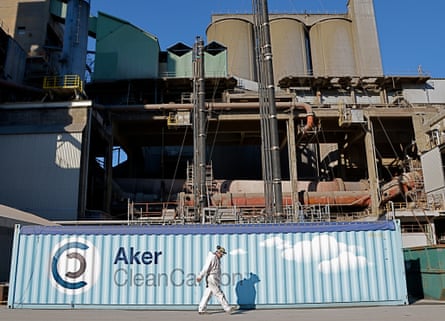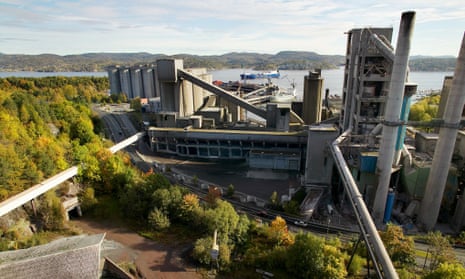Brevik, a small coastal town two hours west of Oslo, has found itself on the front line of a global battle over a technology that is hailed in some quarters as the solution to climate change, but denigrated in others as a reckless and potentially fatal gamble.
Environmentalists are mobilising to protest against plans to fit a cement factory with carbon capture and storage (CCS) technology to remove most of its emissions and bury them underground. But some in the green movement are on the other side of the fault line.
Pushing emissions underground where they can’t change the climate is a seductive proposition and in the face of desperate global warming projections, the global CCS dream still unites unusual allies – Canadian tar sands rollers, the UN’s Intergovernmental Panel on Climate Change (IPCC), oil majors such as Shell and some environmentalists are all behind it.
But progress has been slow. At least 10 CCS-fitted power plants in Europe were supposed to begin piping their carbon emissions into underground tombs this year, rather than letting them twirl into the sky. But none has done so.
The European commission too was supposed to publish plans for improving the CCS outlook last month, but did not.
Missed deadlines, squandered opportunities, spiralling costs and green protests have plagued the development of CCS technology since Statoil proposed the concept more than two decades ago.
The concept behind it is disarmingly simple. Instead of venting CO2 directly into the atmosphere, you scrub it from flue gasses and pipe it – usually in a liquefied form – for storage in an underground repository where it can’t affect the climate.

Fossil fuel companies argue that it is a green way to carry on with business as usual while supplying rising global energy demand. It could also potentially allow developing nations such as India and China to build many more coal-fired power stations without devastating consequences for the climate.
“With CCS in the mix, we can decarbonise in a cost-effective manner and still continue to produce, to some extent, our fossil fuels,” Tim Bertels, Shell’s Glocal CCS portfolio manager told the Guardian. “You don’t need to divest from fossil fuels, you need to decarbonise them.”
“If you take climate change seriously, it is extremely dangerous not to enable this technology for use in refineries, steel, cement, gas and coal plants,” said Frederic Hauge, the founder of the Bellona Foundation, a high-profile mover in Norway’s CCS project. “When combined with biomass, CCS gives us the option of going carbon negative (reducing more emissions than are created) which we need because we don’t have a Plan B – or Planet B.”
Despite the promise, globally, just 13 large-scale CCS plants are operating in places such as Boundary Dam in Canada and Century Plant in Texas, often using the compressed CO2 to prise away tar sands and eek out the dregs of depleted oil wells.
Since the early 1990s, Europe’s only working CCS technology has been in Norway – at Statoil’s Snøhvit and Sleipner offshore gas plants.
Two large projects are planned in the UK – ‘White Rose’ at the Drax coal-fired power station which has received €300m from an EU ETS funding pot, and at Alstom’s Peterhead gas plant. The projects won ‘preferred bidders’ status in a government £1bn competition for such projects. But an early 2015 deadline for final investment decisions was not met. Work on the only other significant project in Europe – the ROAD coal-fired CCS plant in Rotterdam – is also yet to begin.
Despite the billions that Shell says it has invested in CCS, the technology is complex, experimental, and unprofitable, without a carbon price that reflects the cost of carbon emissions to society.
The first financial analysis of Boundary Dam last month found that it generated losses of over $1bn (£0.7bn), which would be paid by local electricity consumers – even though its principal beneficiary was an Albertan oil company.
Current carbon prices in the EU are too low to make CCS attractive to investors. So CCS advocates are pushing for ‘parity of policy’ with renewables and energy efficiency in public funding.
In Norway – the world’s third largest exporter of oil and natural gas – over £1bn has already been ploughed into a CCS project at Mongstad, compared by the then-prime minister Jens Stoltenberg to a “national moon landing”.
But the recipient, Statoil, was never enthusiastic about the project and after technology costs quintupled in a matter of years, sources say that they demanded exorbitant prices from the government for use of steam that their installations were freely venting.
The result was the construction of Norway’s highest-emitting gas plant, with an annual CO2 output of 1.2m tonnes.
But in Brevik, unlike Mongstad, the plant can utilise waste heat from the cement factory. “So we don’t have to add additional heat,” said Oscar Graff, the chief technology officer for Aker Solutions Clean Carbon. “We get it almost for free.”
If all goes to plan, the plant will become Norway’s third operational CCS project in five years time, catching up to 400,000 tonnes of CO2 which could then be piped for storage in an underwater continental shelf. Another 50,000 tonnes would be blended with sulphuric acid and fly ash in a solid waste, which Norcem sources confirm could be stored in various onland cavities, including an underground mine that collapsed in the 1970s.
That in turn has sparked local anger. “A minor CO2 capture seems to be just one partial reason for the new development,” said Øystein Dalland, an environmental professor who lives close to the plant. “This is also about achieving an increased bottom line by the synergy of handling fly ash in the cement production process. But even the idea of CO2 capture and waste handling must be subordinate to basic human rights.”
Carbon capture technology is often more advanced than its transport and storage elements, where there are myriad possibilities for accidents and disputes.
“We can’t take responsibility for transport and storage,” said Per Brevik, a manager of the Aker Clean Carbon CCS project in the Norcem plant. “It is not our core business. Storage is definitely a national task because you have to guarantee that it won’t leak and I don’t think that Norcem would like to have that responsibility.”
A nearly two-mile fracture has already been found close to the Sleipner carbon repository. But the CO2 there will have to be kept underground for many centuries, and not just to prevent climate change.
Some 1,700 people died in 1986, when a Cameroonian volcano erupted, releasing hundreds of thousands of tonnes of CO2 that had accumulated at the bottom of Lake Nyos, over a 16-mile range.
The CCS issue opens a pandora’s box for environmentalists. Many argue that it displaces crucial investment in renewables and energy efficiency for a technology that will reduce CO2 emissions by too little, and too late. Truls Gulowsen, the director of Greenpeace Norway describes carbon capture as a “painful” issue that “absolutely divided the environmental movement” in the Scandinavian country.
Hauge a flambuoyant celebrity in Norway who has been arrested more than 30 times for daring environmental actions compares the green schism to university rows among Marxist-Leninists in the 1980s.
“There is no black and white in the environmental discussion anymore,” he said. To fight climate change, “we need to go with whatever we can and I can’t manage to do that without CCS, even if it means that our former enemies start to become our best allies.”
Rasmus Hansson, the leader of the Norwegian Green Party, believes the issue is more stark. “CCS is basically about catching a problem and stuffing it away under the carpet,” he told the Guardian. “We will then live with the statistical risk of some gigantic underground burp. The problem is the same as with the Gulf of Mexico oil disaster. Things that absolutely cannot happen have a tendency of finally happening.”

Comments (…)
Sign in or create your Guardian account to join the discussion